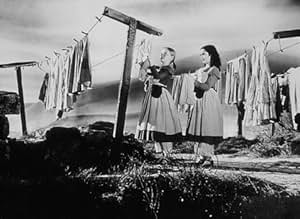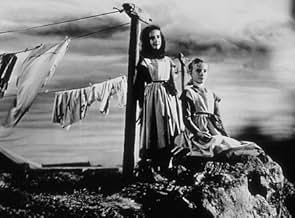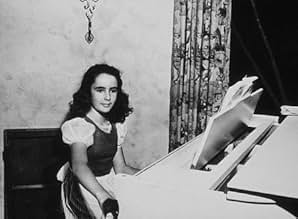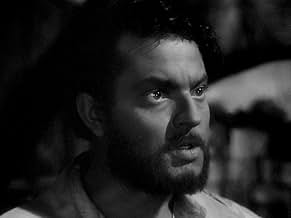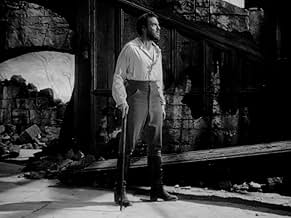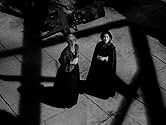Después de una infancia difícil, la huérfana Jane Eyre es contratada por Edward Rochester, el inquietante señor de una misteriosa casa solariega, para cuidar de su pequeña hija.Después de una infancia difícil, la huérfana Jane Eyre es contratada por Edward Rochester, el inquietante señor de una misteriosa casa solariega, para cuidar de su pequeña hija.Después de una infancia difícil, la huérfana Jane Eyre es contratada por Edward Rochester, el inquietante señor de una misteriosa casa solariega, para cuidar de su pequeña hija.
- Dirección
- Guión
- Reparto principal
- Premios
- 3 premios en total
- Mason
- (sin acreditar)
- Guard
- (sin acreditar)
- Bookie
- (sin acreditar)
- Townsman
- (sin acreditar)
- Woman at Party
- (sin acreditar)
- Proprietor
- (sin acreditar)
Reseñas destacadas
Joan Fontaine portrays the shy, demure Jane Eyre. (or is she?) I always believed this was the story of a woman forced to be what society felt a woman should be. Once Jane becomes the governess of Mr. Rochester's ward, she feels free to be the woman she truly is: strong-willed, opinionated and passionate.
Truly, they just don't make movies like this anymore. Not just a love story, this is a tale of finding oneself and realizing one's true destiny.
After a harsh and eye opening childhood, orphan Jane Eyre gains employment at Thornfield Hall as governess to the young ward of Edward Rochester. A Difference in class and life outlook, Jane and Rochester are by definition polar opposites, but a bond exists, a bond that surely can't conquer the mysteries of Rochester the man, and the secret of his estate - can it?
Stevenson's version of the often filmed Jane Eyre has been pored over numerous times before, the constant question that arises is that of just how much input and work did Orson Welles have in the production? Knowing what we now know of Welles' 40s output, Jane Eyre undeniably has the Wellesian stamp all over it, with Fontaine herself quoted as saying the big man was often found behind the camera. This is not to decry Stevenson in any way, he himself would carve out a good career in directing further down the line, but this take on Brontë's famous novel shines because of Welles' presence in front and behind the camera.
With that comes one of only two quibbles with the film as a whole, namely it's Welles' portrayal of Rochester that dominates the film, and not that of Fontaine's Eyre. Which is quite staggering considering he doesn't enter the fray until 34 minutes into ty epic. The other problem, naturally, is that with a running time of just over an hour and thirty five minutes, it was never going to be a detailed adaptation of the novel. However, what exists is still an excellent mounted production, a film pulsing with aggressive atmospherics and simmering emotional passions.
It has been argued that the opposing acting styles of Fontaine and Welles are a distraction, I don't see it that way at all, as one of classic cinemas greatest voices emotionally spars with one of its most beautiful faces, this is monochrome gold dust. In mind of the difference of characters as written on the page, it actually comes off as inspired casting. With the production that surrounds them perfectly in keeping with the characters' state of mind.
The look is assuredly what would become known as film noir, with George Barnes' (Rebecca/Spellbound/Force of Evil) vivid black and white photography dovetailing splendidly with the matte paintings and Gothic set designs. It still amazes me to this day that this film was entirely produced on stage 2 at 20th Century Fox. So many images burn into the memory. From the shards of shadows that accompany young Jane as she stands on the punishment stool at Lowood Institution, put there by the despotic Henry Brocklehurst (a menacing Henry Daniell), to each chiaroscuro lit composition of Rochester in and around the oppressive like family home, the film has visual moodiness in abundance.
Herrmann's (The Devil and Daniel Webster/Citizen Kane) score is crucially in tune as well. Orchestral swirls to portray Jane's longing are counter pointed by the menacing down beats that attack the viewer for Rochester's bluster. Away from the two leads it's young Peggy Ann Garner who delivers the most telling performance. She gives the child version of Jane a sorrowful edge that sets the tone of the film, her early scenes with an uncredited Elizabeth Taylor (beautiful and effectively correct in vocals) are a lesson in child acting. The rest of the cast is filled out with admirable performances from Margaret O'Brien (Meet Me in St. Louis), John Sutton (Captain from Castille), Sara Allgood (The Lodger) and Agnes Moorehead (The Magnificent Ambersons).
This may not be a definitive Jane Eyre adaptation, and the compromised ending does knock it down a point, but all told it's still a top piece of classic cinema. 9/10
Yet when it's not reminding us that it's at heart a version of something else, it's a very good film, falling not too far short of David Lean's "Oliver Twist" - which it resembles. Both films were shot almost entirely in the studio, yet don't feel studio-bound; they feel rather as though the directors had managed to find unusually claustrophobic out-of-door (or, in Lean's case, urban) locations. In both films a portion of every frame is consumed by impenetrable shadow. (Yet "Eyre" is detailed, and makes the best possible use of every frame.) Both films take place around in a callous England of the 1920s. (I got the impression that if Brönte's characters had for some reason gone to London they would have encountered Dickens's, although this impression was destroyed when the rich Londoners visit Rochester's castle.) Both films manage to be sentimental in an agreeable way. Both have excellent musical scores. In fact, this may be Herrmann's best score of the 1940s, certainly better than the one he wrote for "Citizen Kane", which is seems better than it is because the film as a whole is a masterpiece.
If you can, make sure you see a print with a pristine soundtrack. Orson Welles isn't always easy to understand.
It's hard to describe which is the most jaw-dropping surprise in this movie: the Kane-esque gothic expressionism of the cinematography, or the stunning acting performances. Welles plays probably the most romantic leading role of his career as the brooding Rochester, while Fontaine postively glows in an understated turn as the title character. Of particular note are two child actors: Peggy Ann Garner, as the young Jane, who has a brief but dazzling turn to open the picture, and who was better known shortly thereafter for her lead in A Tree Grows in Brooklyn; and the never-yet-equaled Margaret O'Brien, the oscar-winner who played 'Tootie' in 'Meet Me in St. Louis' as Rochester's ward and Jane's charge. Oh, and nearly incidentally, one of Elizabeth Taylor's first performances, as Jane's doomed friend Helen.
One can only speculate how the history of film would've been different had Welles somehow started a trend in Hollywood story-telling like that of this rendition of 'Jane Eyre'. He certainly had enough classics pitched in his early and still hopeful days in Hollywood, and this film, whether or not he deserve direct credit for it, is one of the strongest -- and, despite the pacing, most concise -- retellings of a literary classic in film history. Without too much hyperbole, it's as if Charlotte Brontë were on the level of Shakespeare and Fontaine and Welles forgotten archetypes of deep myth. It's not a stretch to say that this film version is far more accessible to the modern sensibility than the book itself is, without losing the period feel and contemporary feeling of the original text.
8/10, a forgotten classic.
¿Sabías que...?
- CuriosidadesAfter securing the screen rights, David O. Selznick originally approached Orson Welles to play the role of Rochester opposite Selznick contractee Joan Fontaine. He got Aldous Huxley, John Houseman, and Robert Stevenson involved. Ultimately though, he sold the package to Darryl F. Zanuck and Twentieth Century Fox.
- PifiasThe text of "Jane Eyre, Chapter 1" that appears on screen does not correspond to the text of Bronte's novel. Chapter 1 actually opens, "There was no possibility of taking a walk that day. We had been wandering, indeed, in the leafless shrubbery an hour in the morning; but since dinner (Mrs. Reed, when there was no company, dined early) the cold winter wind had brought with it clouds so sombre, and a rain so penetrating, that further out-door exercise was now out of the question."
- Citas
[first lines]
Jane Eyre: [narrating] My name is Jane Eyre... I was born in 1820, a harsh time of change in England. Money and position seemed all that mattered. Charity was a cold and disagreeable word. Religion too often wore a mask of bigotry and cruelty. There was no proper place for the poor or the unfortunate. I had no father or mother, brother or sister. As a child I lived with my aunt, Mrs. Reed of Gateshead Hall. I do not remember that she ever spoke one kind word to me.
- Versiones alternativasThere is an Italian edition of this film on DVD, distributed by DNA srl, "JANE EYRE (1943) + LETTER FROM AN UNKNOWN WOMAN (1948)" (2 Films on a single DVD), re-edited with the contribution of film historian Riccardo Cusin. This version is also available for streaming on some platforms.
- ConexionesFeatured in AFI Life Achievement Award: A Tribute to Orson Welles (1975)
Selecciones populares
- How long is Jane Eyre?Con tecnología de Alexa
- What is 'Jane Eyre' about?
- Is 'Jane Eyre' based on a book?
- Is this the first film adaptation of the novel?
Detalles
- Fecha de lanzamiento
- País de origen
- Sitio oficial
- Idioma
- Títulos en diferentes países
- Jane Eyre
- Localizaciones del rodaje
- Empresa productora
- Ver más compañías en los créditos en IMDbPro
Taquilla
- Presupuesto
- 1.705.000 US$ (estimación)
- Duración1 hora 37 minutos
- Color
- Relación de aspecto
- 1.37 : 1
Contribuir a esta página



